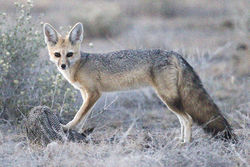Cape fox
| Cape fox |
|---|

|
| Scientific Classification |
|
| Scientific Name |
|
Vulpes chama |
| Cape fox pup! |
The Cape Fox, known by the scientific name Vulpes chama is a fox that belongs to the South African savannahs and deserts. Due to the hot, arid and humid environments of the savannahs and deserts, they wind down in underground tunnels that they use to stay 'air conditioned'. The Cape fox had been given several other generic names which are the Cama fox, Silver-Backed fox and Silwervos.
The Cape Foxes are omnivorous, nocturnal creatures with small, neutral colored bodies. Their gracile bodies from the head to the tip of their tails are just under three feet at most. These foxes are born each spring or summer time and become able to reproduce at only nine months. The father of the litter provides for his family during the beginning then leaves. These pups after birth will stay protected with their mother until they are five months old and ready to branch out. As adults the Cape Fox can be a nuisance to farmers in the area.
When The Cape fox is compared to the Fennec they have considerable resemblance in ecology and life cycles. These small true foxes are native to opposite ends of Africa from each other; north and south.
Body Design
The Cape Fox (Vulpes chama) is small by God's design. Excluding the tail, the foxes are twenty-one and a half inches long. To add to the twenty-one and a half inches is the Cape fox's thirteen and a half inch long tails, is the full length of these foxes! Males are on average 5.7 pounds and females coming in slightly less, on an average of 5.4 pounds.[2]
The small Cape Fox has fur that is black, gray and sliver with a tan-ish belly. Along with these colors, they have a brown and red tinted head.[3]
Considering the Cape Fox is from the family Canidae and their body size, their legs allow them to swiftly reach a rate of forty-five miles per hour. [4]
Life Cycle
When a female or male Cape Fox is about nine months old it is able to mate. In the Winter (about July through August, where they are native) males and females match up for the time period of conception through the launch of the cubs' lives.This pregnancy period is about fifty days long and can contain from three to five baby Cape Foxes. The cubs are generally born in the later spring time and through the summer. After the starting point of the cubs lives, the male leaves and thus discontinues care for the family. The cubs stay in their protective burrow for the first four months under the care of their mother until they are five months. By the time they are five months of age, the cubs generally venture out on their own! These animals will live on an average of ten years, enough time for a female to have nine or more litters.[2]
Ecology
The Cape Fox is identified by other common names such as the Cama Fox, Silver Backed Fox, and Silwervos.[3]
The Vulpes chama are native around South African parched deserts and savannas. The native areas in South Africa includes the edge all the way up to Namibia, Botswana, Transvaal, and Natal.[2] Though the Cape fox lives in a warm areas where they dig shelter-like tunnels to protect themselves from the climate. [5]
Cape Foxes are fundamentally carnivores who feed on small mammals, reptiles and insects. They can also be burdens on farmers because of their predatory behavior with some livestock.[2] When faced with a predator the foxes will spit and growl as a warning.[5] Due to the rivalry with similar animals they could have a constrained population.[2] But, based on the time of year, their regimen can be of fruits, vegetables and bigger mammals (which makes them overall omnivorous). Cape Foxes are also nocturnal, they are not active in the day time besides when they are pups.
These Cape Foxes are independent in their nature and are unusually seen rummaging as a group.[6]
Cape fox vs. Fennec fox
The Cape Fox and Fennec Fox belong to the same genus (Vulpes) but, different species (Chama and Zerda). They are both found in places in Africa; the Cape Fox in the South and Fennec in the North. Both foxes are also not in danger of extinction.
On average, the Cape fox is four to five inches larger in length compared to the Fennec fox. They also have a difference of about two to three pounds in weight. Both species are nocturnal and have a similar appetite consisting of small mammals, reptiles and plants.
Fennec Foxes have fairly similar reproduction and life cycles. For the Cape fox the males only stay for a short while to support the family when the pups are young but the Fennecs' males are not around the pups until they are older. The Fennec has a litter once a year that is born anytime from January to March. The gestation period or pregnancy is the same, being on average of 51 to 52 days for both species. Both foxes have about the same amount of cubs ranging from two to five per litter.[7]
There are certain unique characteristics the Fennec foxes hold that differentiate this species from that of the Cape Fox. They have the biggest ears in proportion to their small bodies which can grow up to almost half of a foot in height![8]
Video
The Cape fox in a natural habitat.
References
- ↑ Vulpes chama Wikispecies. Web. Last edited on January 12, 2018. author unknown
- ↑ 2.0 2.1 2.2 2.3 2.4 Rohde, Kristen. Cape fox Animal Diversity Web. Web. Accessed on April 12, 2018
- ↑ 3.0 3.1 Wild Animals of Africa Wacky Wildlife Wonders. Web.Accessed on April 12,2018. Author Unknown
- ↑ Bradford, Alina. Foxes:Facts and Pictures Live Science. Web. Published on September 14, 2017.
- ↑ 5.0 5.1 Cape fox {Vulpes chama} SA-Venus. Web. Accessed on April 29th, 2018. Author Unknown
- ↑ Cape fox fact file Widescreen Arkive. Web. Accessed on April 14, 2018
- ↑ Fennec Fox Animal Corner. Web. Accessed on April 25, 2018. Author Unknown
- ↑ Fennec Fox The Animal Facts. Web. Accessed on April 29th, 2018. Author Unknown.




